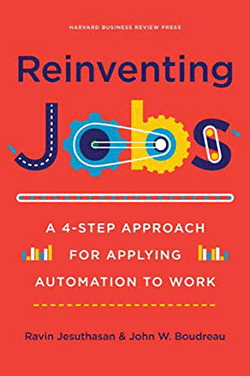By William Carmichael
“If you are a leader wrestling with where, when, and how to apply automation in your organization, you’re in good company” begins Reinventing Jobs- A 4-Step Approach for Allying Automation to Work by Ravin Jesuthasan and John W. Boudreau. This innocuous opening establishes what for many is the formidable reality that work, our jobs, our way of life as we know it is constantly being reevaluated. And like it or not, artificial intelligence (AI) is waiting in the wings. But simply asking which jobs or humans, for that matter, will be replaced by automation fails to take into account how work and automation will evolve. This progression and its aftermath is what this excellent guide is all about.
AI and Robotics Are Here. Now What?
Reinventing Jobs is not about robots or automatons or even highly functioning androids. Rather, our authors speak of automation as the pivotal future capability for leaders to “optimize human and automated work.” True, robotics does allow a reinvention of some industries but does this come at the price of human work? Case in point. Did the ATM completely remove bank tellers from the equation? The answer to this question is yes and no. As our authors describe, this ATM parable is a useful one for leaders, workers, and everyone else, “because it illustrates why the simplistic idea of technology replacing human workers is so misleading.” No one can argue that technology begets technology but it can be argued that this explosion of technology begets a zero-sum-game of sorts for every new technology requires maintaining and this takes people. More specifically, this takes dedicated skill and understanding, which we all know, still requires a human touch.
Reinventing Jobs suggests that business leaders need a new set of tools to answer the questions that automation poses. Going beyond traditional concepts like “job,” our authors show us that regardless of industry, automation calls for a reexamination of what a job really is. They show leaders how to determine variations of tasks within jobs and then how to reconstruct those elements into new and different combinations. They also make very clear that the ongoing debate about humans being replaced by machines is far from over. What we are left with then is the necessity for leaders to optimize what is known as human-automation combinations that are not only more efficient but generate higher returns on improved performance.
What Does the Future of Work Look Like?
Recently, an online news report detailed how a hospital utilized an automated video to give a terminal diagnosis to a patient. Even if this were true it gives us reason to pause. Simply because we have the technology to use does not mean we should use it! Here, Jesuthasan and Boudreau understand the moral and divisive elements that automation steers us into. Still, the reality is that technology and automation will not be denied. Therefore, leaders must adapt and overcome. But how?
Once the decision has been made to adopt automation and artificial intelligence technologies, leaders face difficult and persistent questions about how to implement that decision. Questions such as:
- How, when, and where should we apply automation in our organization?
- If so, will it be a stark choice between humans vs. machines?
- How do we stay on top of these technological trends as work and automation continue to evolve?
As harmless as these questions appear, Reinventing Jobs is not for the faint of heart nor is a light read. It gets into issues like business process reengineering, identifying reskilling pathways for talent, aligning executive compensation to the new business realities, pivotal strategic goals, augmentation with cognitive automation, automation compatibility, and many more. Jesuthasan and Boudreau assert that the very nature of an organization will require rethinking, which means fundamental changes in the definition and execution of leadership. They also propose that everyone approach their own careers as a constant process of deconstruction and reinvention as advances in automation continue. I highly recommend this book for those who are in industries already adopting technology and automation.
The biggest take-a-way for readers I believe is that AI will significantly disrupt and empower the global workforce. No it won’t happen all at once or in every industry or job but it will happen and leaders will need an automation strategy that realizes its benefits. Leaders also need a clear-eyed way to think about how these strategies will specifically affect their organization. So again, the right question isn’t which jobs are going to be replaced, but rather, what work will be redefined, and how? Reinventing Jobs gives an honest, eye-opening look at the future around us.
Structure and Layout
Reinventing Jobs is structured into two main parts; Part One- Optimizing Work Automation and Part Two- Redefining the Organization, Leadership, and Workers. It is designed as a linear read that unfolds as readers make their way through it. As an example, Part One consists of a four-step process which lays out the stages for leadership to view job functions systematically. It explains how automation can or should be integrated. Part Two comprises three components that emphasize the implications of automation upon individual jobs and the organization. It also contains groundbreaking primary research which provides enormous credibility. This is an informative and important read, and I highly recommend it.
Who Will Benefit Most from This Book?
Senior Leadership, Project Leaders, Supply Chain Management.
About the authors:
Ravin Jesuthansan is Managing Director at Willis Towers Watson and a recognized global thought leader on the future of work. He is a senior member of the World Economic Forum’s Steering on Work and Employment and has been recognized as one of the 25 most influential consultants in the world. John Boudreau is Professor of Management Organization at the University of Southern California’s marshal School of Business and Research Director at the university’s Center for Effective Organizations.

william.carmichael@strayer.edu www.strayer.edu
